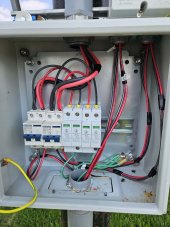For those that have a wooden array structure and do not want to run a ground wire back to the mains because of distance what would be the best way to simulate a metal pv array structure to eliminate the problem??The structure is just an auxiliary grounding rod according to NEC.
I think some believe an EGC from array to main system grounding is not needed as there is a ground rod at the array. Any grounding at the array is just an auxiliary ground. It is required to connect it to main grounding system.
When it comes to grounding, it would be wise to follow it. I think some like to interpret certain sections or choose a menu of only certain things. When it comes to grounding, it is quite specific.
As long as there is a grounding electrode at the main panel with N-G bonded and an EGC that runs with current carrying conductors from the PV array, then it is according to NEC grounding requirements. Anything else is fluff and not needed or required, in other words, money down the toilet.
Many believe they can use either a grounding electrode or the array structure as the grounding for the array. This is incorrect, any grounding at the array is an auxiliary ground. An EGC needs to be run from array/auxiliary ground to main grounding system which is usually at the inverter/electrical panel installation. An auxiliary ground is not needed, nor is it not permitted. It just "exists".
What NEC should do is to not allow an auxiliary grounding electrode, it would eliminate confusion. A metal PV array structure is allowed but not an auxiliary grounding electrode.
Bolt a metal plate to one leg of the wooden mount at the bottom and run a cable from the arrays frames to it? Were just talking about eliminating the equivalent of static discharge like you built up sliding off a truck seat getting out right? Well except it never ends
For the record I don't know that I even have this problem but I figure why not eliminate it now just in case



